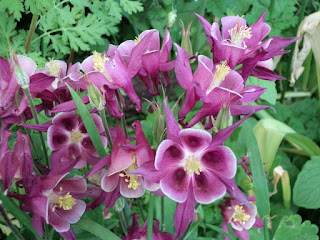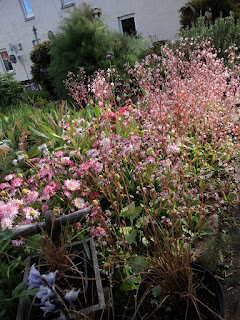And nowadays June seems to be the month I enjoy my garden the most. There is both promise and fulfilment. It begins with the days getting longer and it ends with the nights drawing in, The slugs have not yet devastated the Hostas and the flowers have a subtlety that the later summer bloomers lack. Can you see what I mean?
The blue Hosta sieboldiana - named after the German botanist Philipp Franz von Siebold who introduced the parents of most modern Hostas to Europe from Japan in the 19th Century.
(Additional trivia: the journal of the Royal Botanic Garden Edinburgh is also named in his honour)
Hosta 'Sharmon' - this particular plant is now ten years old, having survived two moves and seems to be rather happy in its current spot - the slugs will get it eventually though - but then their pooh enriches the earth so win-win really.
Hosta albomarginata 'Blue Mouse Ears' is a dwarf variety from Park Green Nurseries - it is only nine years old: just a baby. Note the sycamore seed deliberately placed to give you a sense of scale.
Hosta 'So Sweet' is one whose flower gives off a sweet scent if grown in the sun - I, of course, have mine in the shade because I am logical that way.
This plant was originally growing in a pot in mum and dad's garden and came to us in the form of a cutting for my wife Sue's birthday in 2004. It was our first Hosta! I had no idea what variety it was until recently I identified it tentatively as Hosta 'Risky Business.' The name seems apt on all kinds of levels. It has had many a battle in life but it's still here and is flourishing.
However, June is not just about greenery. This time of month is perfect for one of my other favourite plants: Aquilegia also known as Granny's Bonnets and Columbine. Our first Aquilegia was a self-sown rosette in 2004. We had just begun gardening and had no idea what this attractive foliage was growing in gravel in a corner, We left it to see what would happen and the following year it put up a delightful purple flower which I now know to be Aquilegia vulgaris - the British native species. I've since grown many from seed but in this garden, so far, I have grown primarily Biedermeier Mix. Can a flower be subtle and showy at the same time? I think so:
The Wild Flowers are beginning to look good now too:
A haze of Bluebells and Forget-Me-Nots: Hyacinthoides and Myosotis.
Unlike those in Glen Nevis I can't be sure mine are the British native H. non-scripta - in fact, almost certainly not. But I didn't plant them - they were here when I came.
A pink and white haze this time created by London Pride - Saxifraga x urbium.
London Pride has been handed down to us,
London Pride is a flower that's free.
London Pride means our own dear town to us,
And our pride it forever will be.
Grey city,
Stubbornly implanted,
Taken so for granted
For a thousand years.
Stay, city,
Smokily enchanted,
Cradle of our memories,
Of our hopes and fears.
More virtue in the shape of Honesty - Lunaria annua. When flowering is over this will form seedheads that turn silver and will later shine through the shortest of days.
If Saxifraga x urbium is London's Pride then Red Campion, Silene dioica, could easily be Fife's floral emblem for it seems to bloom on every roadside across the Kingdom.
Alchemilla alpina is a montane version of Lady's Mantle - I didn't grow this from seed but it is happily self-seeding in the trough and one year I shall transplant because I love the silver edged foliage:
The Sweet Cicely, Myrrhis odorata, I planted last year seems to be taking to its spot and I hope to see it spread. This is a naturalised rather than native plant - introduced to me by my good friend Katie Croft who advised me of its sugar-alternative properties. Me, I grow it primarily because I think it is beautiful.
One of my pure joys in this garden is the annual cascade of the Hawthorn, Crataegus monogyna. I feel so privileged to have inherited a garden that contains this magnificent specimen - something I am unlikely to have witnessed had I had to grow one from seed.
This June has felt a bit too cold to be casting any clouts just yet, though.
There is, of course, still lots of promise in June too.
Some of that promise comes from plants I am raising.
Some of it comes from plants I have planted.
And is it just me who sees in the Scots Pine, Pinus sylvatica, the shape of a Christmas Tree complete with candles and baubles just waiting for a party to begin? Have a Joyful June, wherever you are.























Hi Jeeb,
ReplyDeleteReading this blog with the customary beautiful photos gives me a clear picture of your happiness with the month of June or as Maureen would say "June surely gives you gladness in your heart". Never knew that you had so many different plants growing in your garden and each has their own story. Thanks again for sharing.
Rudi
Hi Jeeb,
ReplyDeleteReading this blog with the customary beautiful photos gives me a clear picture of your happiness with the month of June or as Maureen would say "June surely gives you gladness in your heart". Never knew that you had so many different plants growing in your garden and each has their own story. Thanks again for sharing.
Rudi
Stuart this is such a lovely and informative account of your garden in June. Thank you for this happy and clever blog x
ReplyDelete